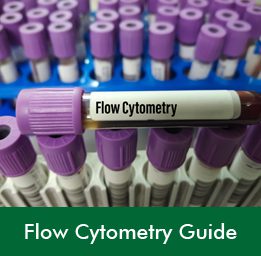
Generic Troubleshooting Guide for FC Products
No signal or weak fluorescence intensity
1. The primary antibody and the secondary antibody are not compatible.
Use secondary antibody that was raised against the species in which the primary was raised (e.g. primary is raised in rabbit, use anti-rabbit secondary).
2. Not enough primary or secondary antibody is bound to the protein of interest.
Increase concentration of antibody. Incubate samples with antibodies for longer at 4°C.
3. Intracellular target not accessible.
Ensure adequate permeabilization. To prevent internalisation of cell surface proteins, everything must be done on ice or at 4°C, with ice cold reagents, to stop all reactions. Adding sodium azide will prevent the modulation and internalization of surface antigens which can produce a loss of fluorescence intensity. For staining of cell lines, trypsin can often induce internalisation of cell surface proteins, particularly cell surface molecules and more gentle detachment methods may be required.
4. Fluorochrome conjugate too large for intracellular staining.
Fluorochromes for intracellular staining experiments should have low molecular weight. Large molecular weight flourochromes can reduce antibody motility and possibly its entry into the cell.
5. Lasers not aligned.
Ensure lasers on flow cytometer are aligned correctly by running flow check beads and adjusting alignment if necessary. If the lasers do not align correctly or if drift occurs, you may need to consider having the machine serviced.
6. Target protein not present or expressed at low level.
Ensure tissue/cell type expresses target protein and that it is present in a high enough amount to detect.
7. Soluble/secreted target protein.
The target needs to be membrane bound or cytoplasmic to be detected by flow cytometry. A golgi-block step, such as with Brefaldin A, may improve the signal achieved for intracellular staining.
8. Offset too high or gain too low.
Use the positive control to set up the flow cytometer correctly again, using the offset to ensure the fluorescent signal from cells is not being cut off, and increase the gain to increase the signal (within reason – care should be taken).
9. Fluorochrome fluorescence has faded.
Antibody may have been kept for too long or left out in the light. Fresh antibody will be required.
10. Signal not correctly compensated.
Check positive and negative single colour control is set up correctly on flow cytometer and gated/compensated correctly to capture all relevant events.
High Fluorescence Intensity
1. Antibody concentration too high.
This will give high non-specific binding or very high intensity of fluorescence. Reduce the amount of antibody added to each sample.
2. Excess antibody trapped.
This can be a particular problem in intracellular staining where large fluorochrome molecules on the antibody can be trapped. Ensure adequate washing steps and include tween or triton in wash buffers.